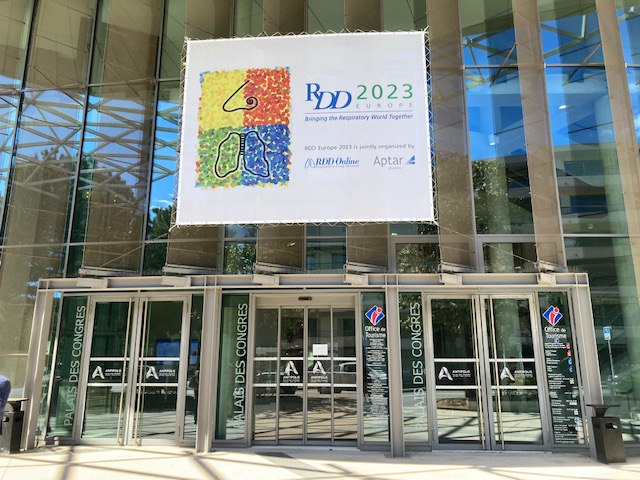At RDD Europe 2023, which took place May 2-5 in Antibes, France, Richard Dalby noted in his opening remarks that approximately 420 inhaled and nasal drug delivery experts from 28 countries were attending the conference in person with another 20 or so delegates attending virtually. Noting that 2023 was the first in-person version of RDD Europe since 2019, he welcomed delegates back to the Palais des Congrès Antipolis which had previously hosted the meeting in 2015 and 2017. Before officially opening the scientific portion of the program, Dalby took time to acknowledge the recent passing of influential OINDP expert Charlie Thiel.
As at other recent OINDP meetings, much of the focus at RDD Europe 2023 was on sustainability, with speakers addressing issues related to device materials and recycling as well as lower-GWP propellants. Nasal drug delivery, especially nasal powder formulations and dual delivery to the lung and nose; inhaled delivery of biologics; and alternative bioequivalence approaches were also hot topics. And in discussions of all of those issues, delegates persistently raised questions about how the FDA and other regulators would deal with new technologies.
Lower-GWP propellants
With pharma companies like Chiesi and AstraZeneca committed to launching lower-GWP MDIs within the next few years, demand for information about the new propellants is high, and RDD Europe 2023 included a number of posters, talks, and workshops on the subject. Zephex HFA 152a maker Koura and Solstice Air HFO-1234ze(e) maker Honeywell both promoted their propellants in the exhibition and presented new data on their products.
Koura has been presenting data on 152a since at least 2016 and has widely discussed considerations for formulating with the new propellant, including at last year’s RDD meeting. Acknowledging the flammability issue for 152a, Koura’s workshop on “Dry Powder Dosing of APIs: An Alternative Filling Technique for pMDIs” covered a filling method that could lead to “mitigation of some safety measures associated with P152a’s flammability.” Koura also presented a poster titled “Anti-Microbial Properties of Low-GWP pMDI Propellant P-152a” with data showing that substituting 152a for 134a or 227ea should not require any additional formulation changes to deal with microbes since the anti-microbial properties of 152a are very similar.
In the Posters on the Podium session, Honeywell’s Greg Smith described a test that the company performed to demonstrate that its propellant would not be flammable under normal operating conditions. Smith explained that HFO 1234ze(e) is only flammable if all 4 of the following conditions are met: temperature ≥ 30C, RH > 50%, concentration within a narrow range. He described an experiment using an incandescent wire that failed to ignite the propellant over a range of temperatures from 26-86C and relative humidities from 50-90%.
Honeywell’s workshop, titled “HFO-1234ze(e): Adopting A Low-GWP Propellant For Metered Dose Inhalers” covered formulation considerations as well as manufacturing conditions, concluding that “Solstice Air is a near drop-in replacement for HFA-134a formulations.” AstraZeneca’s David Lechuga-Ballesteros reinforced that conclusion in his podium talk, “Co-Suspension Aerosphere Technology Enabling the Pharmaceutical Transition to Non-HFA Pressurized Metered Dose Inhalers With Reduced Environmental Impact,” in which he described reformulating Breztri Aerosphere with HFO-1234ze(e).



